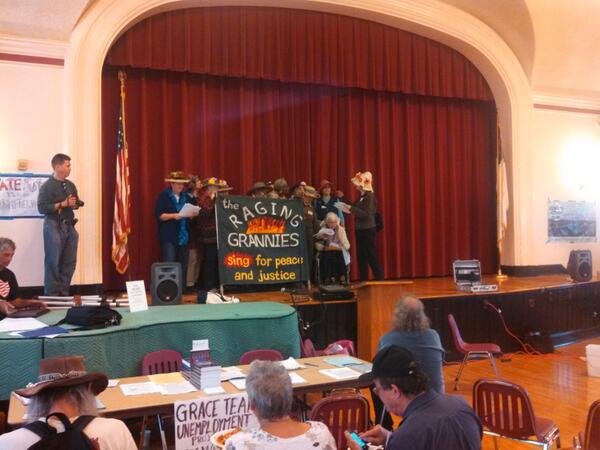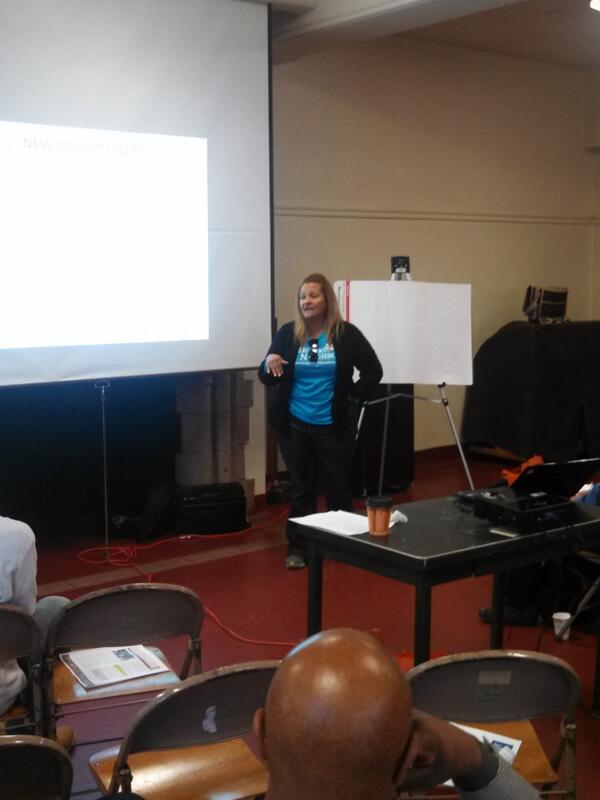The Scales of Climate Justice in the City of Homes…
EDITORS NOTE: We apologize that this post was delayed two weeks due to illness and other events.

Raging Grannies sang during the Lunch Break (WMassP&I)
SPRINGFIELD—Miles away from ocean and acclimated to the extremes inherent in New England weather, Springfield seems better insulated from the catastrophic effects of climate change than Boston. But appearances deceive. While the actual impact may be more subtle, poor environmental and related policies, exactly the kinds that provoke climate change, can and does have a pernicious effect on cities like Springfield and its more vulnerable residents.
To consider these matters, local and state groups staged a climate justice conference at Trinity United Methodist Church in the city’s Forest Park neighborhood late last month. From breakout groups on the military’s climate impact to food supply sustainability to transportation, the conference highlighted both the immediate and long term need to and challenges of addressing the world and the region’s environmental problems.

Jacqui Patterson, NAACP Environmental Justice Director, was the Keynote speaker (via climateactionnowma.org)
The event was sponsored by Arise for Social Justice, a Springfield-based activist group, the Massachusetts chapter of Climate Action Now, and the Greater Springfield NAACP. A host of other groups were also cosponsors. The keynote speaker was the Environmental Justice Director for the national NAACP, Jacqui Patterson.
Organizers had reason to be pleased with turnout. The church parking lot was filled spilling out onto Continental Street. After the first breakout sessions ended, lines of people thronged the vendor booths and food tables while the Raging Grannies regaled the conference in song.
Michaelann Bewsee, a city activist and longtime fixture at Arise, said 210 people registered, but estimates the number is closer to 230 counting folks who did not bother registering (the event was free). Susan Reid, the Massachusetts Director for the Conservation Law Foundation, a cosponsor of the conference, guessed that just under 200 were attendance, an estimate she later revised upward.
“It was encouraging to see such a racially, ethnically and socioeconomic ally diverse crowd in attendance,” Reid said noting also that the geographic distribution of attendees was also encouraging.

Michaelann Bewsee (via michaelannland blog)
The purpose of the conference was informational, but also about movement-building. That is, how do those who care greatly about moving the policy needle on climate and the environment get organized to bring about change? Both Bewsee and Reid emphasized this point in follow up emails to WMassP&I.
Conspicuously missing were elected officials who may have the most direct impact on policy. Bewsee said only one candidate for Springfield City Council at-large, Ernesto Cruz, attended.
Speaking to his attendance in an email to WMassP&I, Cruz said, “It’s not often that people from all over the state come to Springfield to talk about the bigger issues being discussed nationally and at the state level.” Cruz also noted the lack of local officials at the conference. Cruz’s history included activism on environmental matters that affect public health, particularly among communities of color.

A PVTA bus (via urbancompass.net)
The efforts at movement building were particularly apparent during the transportation breakout session, which included discussions about improvements to the Pioneer Valley Transit Authority (and the fight to bring them about), transportation funding and the rise of biking as a transportation alternative.
One speaker, David Elvin a planner at the Pioneer Valley Planning Commission described how the transportation funding bill the Massachusetts legislature passed earlier this year essentially restores PVTA funding to its pre-2002 recession levels. While not as far as the agency may need to fully serve its neediest populations, the increased funding will go a long way to restoring long-since cut services and improving others.
While poor public transportation complicates indirectly causes higher emissions of carbon as city-dwellers are forced into cars, it may have a bigger impact on the poor directly. Without adequate public transportation, particular out of poor neighborhoods with few job prospects, poorer residents often must go to extraordinary ends or rely on rides to get to work, doctors appointments or church.

Elsie Sanchez from Neighbor to Neighbor (WMassP&I)
Elsie Sanchez from Neighbor to Neighbor of Massachusetts told WMassP&I how some people in her community could not find transportation from their home in Springfield to their job in Holyoke. There were “times when they did not find people on a Sunday evening,” and then had to “Walk from Holyoke to Springfield,” she said. Some ultimately had to give up their jobs.
Sanchez said the impact goes beyond jobs and medical appointments, but family time and church as well. “Let’s think of the family who wants to take them to the movies,” she said. The lack of transportation is “something that affects the whole human being,” she added noting that some cannot go to church either without a ride
Other complications are the disconnectedness of the PVTA system. Only one, lumbering, path exists between Springfield and Northampton, for example, and it requires several connections. Meanwhile, north of the tofu curtain, the often sardonic name for the mountain range separating Hampden and Hampshire counties, UMass-Amherst pays PVTA to run a free service between Amherst and downtown Northampton. Attempts to fix this have been met with lawsuits from Peter Pan Bus Lines.
The result is not only cutting off Springfield area residents from Noho, but also complicating college students’ rides back to the lower Valley and, possibly enjoying the attractions like the Quadrangle and the Hall of Fame.

A bike lane near BU in Boston (via nytimes.com)
The emphasis on city living and reducing the climate footprint is not just about public transportation, however. Jimmy Pereira of MassBike, an organization that works to improving and encouraging bicycling as an alternative form of travel, said that the need for more biking infrastructure is high.
Pereira is the Springfield program associate for Mass Bike working in a consultative role with the Department of Public Works to address the “lack of [bicycle] facilities and safety education.” He said that interest in biking as an alternative form of transportation has risen, particularly among younger folks, in part because it is less expensive than a car.
Pereira said that although some bike infrastructure could be pricey, “Bike lanes, paint on the road is very inexpensive. Any city can do, whether you are acity or suburb.”

Susan Reid (via clf.org)
A clear message just from the transportation breakout group alone was the need for the public to apply pressure on the PVTA and other transit agencies, but also local officials. Richard Gardner, president of the Amalgamated Transit Union Local 448, which represents PVTA drivers, stressed this point during his presentation and has in the past. The mayors of the PVTA’s service area, for example, are on the authority’s advisory committee and therefore are another point of contact for transit advocates or for that matter anyone concerned about climate change or the impacts policy on the poor. But Gardner and others also said that pushing to have members of the board selected by riders should also be a focus.
Reid, of the Conservation Law Foundation, said the conference offered an opportunity for movement building, “I’m optimistic that some of the best ideas brought forward…will be translated into action that will move the needle in confronting climate change”
Cruz, the Council candidate, who said he attended the civic engagement panel, has made public health, particularly air quality, part of his platform. He agreed that applying pressure, particularly on the local level could have the biggest impact on national and global environmental issues.
“When the debate is opened to the best ideas, people will make the right decisions,” Cruz said. “My hope is that awareness increases public participation and fresh ideas to help propel Springfield forward when it comes to environmental policy.”
